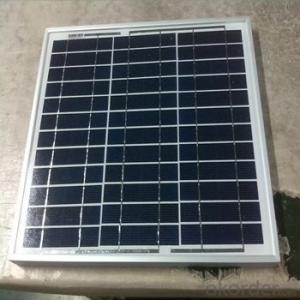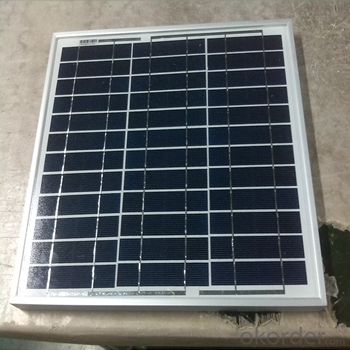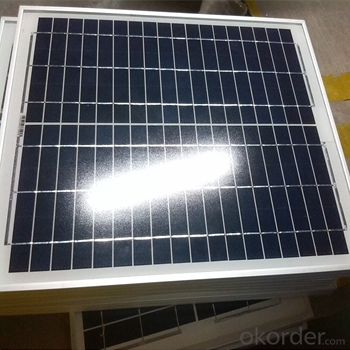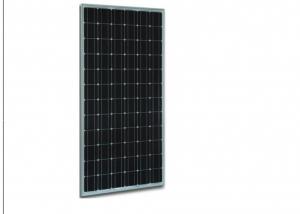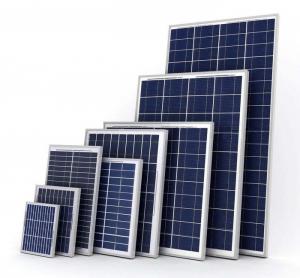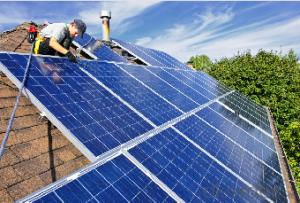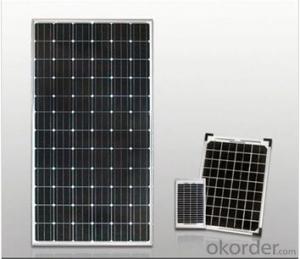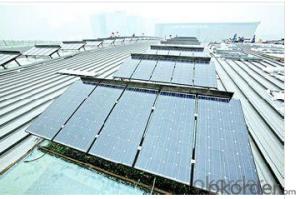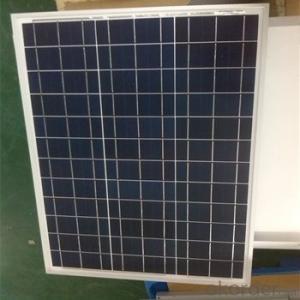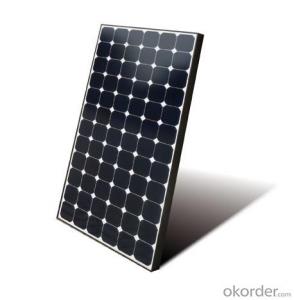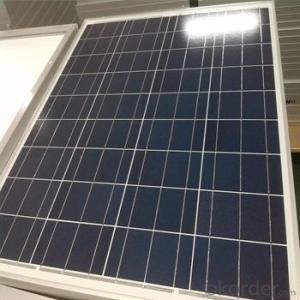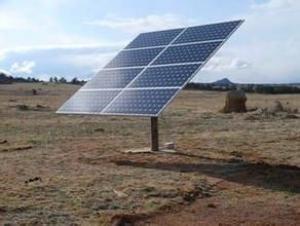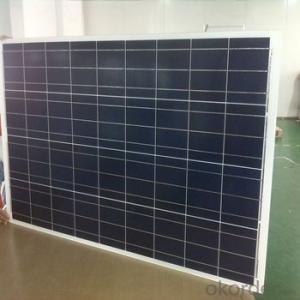Maxeon Solar Panels - Polycrystalline Solar Module 10W CNBM Series
- Loading Port:
- Shanghai
- Payment Terms:
- TT OR LC
- Min Order Qty:
- 25 pc
- Supply Capability:
- 20000 pc/month
OKorder Service Pledge
OKorder Financial Service
You Might Also Like
Polycrystalline Solar Module-10w CNBM Series
High efficiency crystalline solar cell. Even if under the weak light, the solar module can produce maximum power output.
II Tempered glass (toughened glass): Anti-reflecting coating and high transmission rate glass increase the power output and mechanical strength of solar module.
III EVA and TPT: Using high quality EVA and TPT to prevent destroying and water.
IV AI frame: Without screw, rner connection. 6 holes on the frame can be installed easily.
V Junction box: Multi function junction box with water proof.
VI Long lifetime: ≥25 years; Less power decrease.
VII Good performance of preventing from atrocious weather such as wind and hails.
VIII Resisting moisture and etching effectively, not effected by geology.
IX The certificate issued by international authority: UL, TUV, IEC, CE.
Standard Test Conditions of Polycrystalline Silicon Solar Panel
The opto-electrical specifications shown below are stabilized values being measured at Standard Test Conditions, Irradiance: 1000W/m2, Spectrum: AM1.5 at 25°C, The info below is subject to manufacturing tolerances. Where appropriate minutes of measurement are available and are used for the dimensioning of the installation.
Advantages of Monocrystalline Silicon Solar Panel
• CNBM Solar performance guarantees for 25 years
• 12 years guarantee for workmanship
• Timeliness of delivery
• Quality Products certified (TÜV, UL, CE, ISO)
Specification
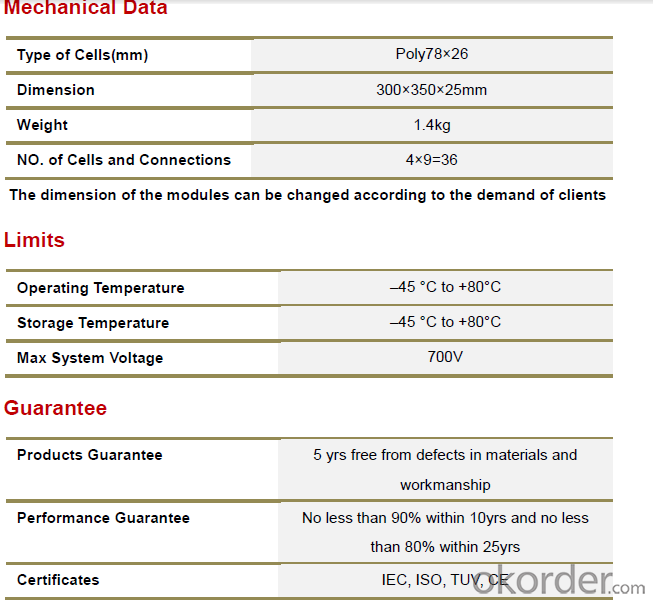

Certification
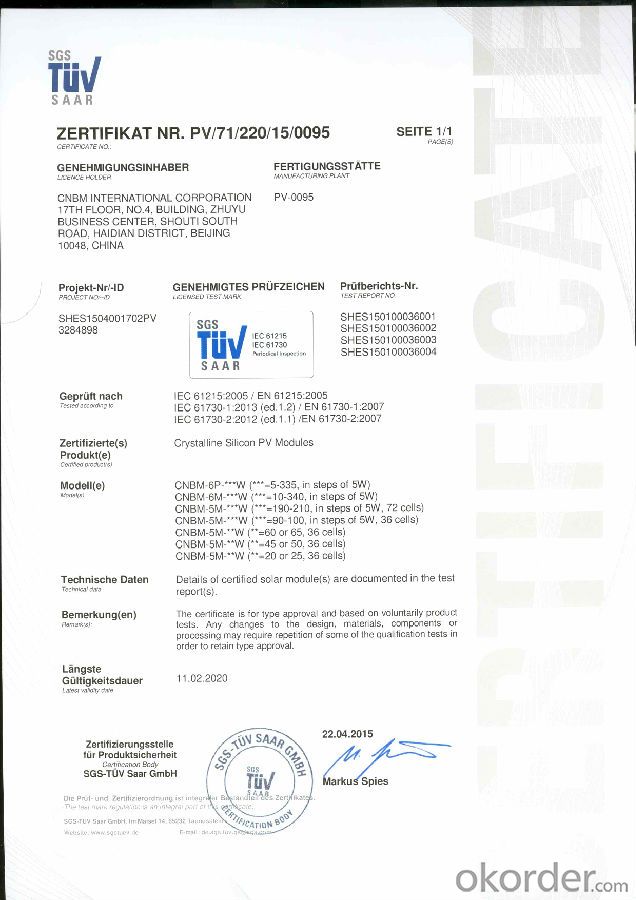
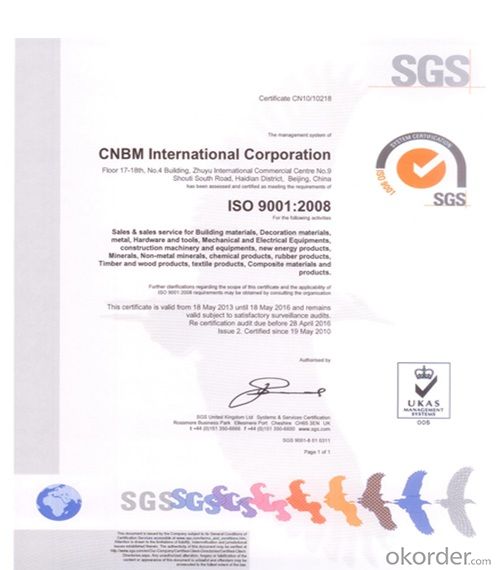
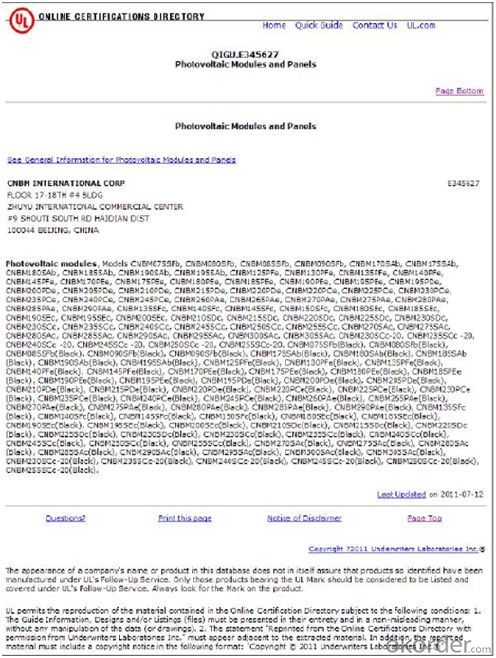
FAQ
We have organized several common questions for our clients,may help you sincerely:
①What price for each watt?
It depends on the quantity, delivery date and payment terms,
②What is your size for each module? Can you tell me the Parameter of your module?
We have different series of panels in different output, both c-Si and a-Si. Please take the specification sheet for your reference.
③Can you provide the peripheral products of the solar panels, such as the battery, controller, and inverter? If so, can you tell me how do they match each other?
Yes, we can, we have two companies for solar region, one is CNBM International, the other is CNBM engineering Co.
We can provide you not only the solar module but also the off grid solar system, we can also provide you service with on grid plant.
④What is your warranty system?
Our product performance guarantees for 25 years
• 12 years guarantee for workmanship
• Timeliness of delivery
• Quality Products certified (TÜV, UL, CE, ISO)
⑤How do you pack your products?
We have rich experience on how to pack the panels to make sure the safety on shipment when it arrives at the destination.
⑥ Can you do OEM for us?
Yes, we can.
⑦How long can we receive the product after purchase?
In the purchase of product within three working days, We will arrange the factory delivery as soon as possible. The pecific time of receiving is related to the state and position of customers.Commonly 7 to 10 working days can be served.
- Q: Can solar panels be installed on vehicles?
- Yes, solar panels can be installed on vehicles. Many electric vehicles and some hybrid vehicles come equipped with solar panels to help charge their batteries. Additionally, solar panels can be installed on the roofs of various types of vehicles, such as RVs, boats, and campers, to generate electricity for powering onboard appliances and systems.
- Q: i am looking for solar panels and wind mill to put around our house and i was wondering were to find them
- From a decent solar panel store. Or you can get on the Internet and look for someone in your area.
- Q: Can solar panels be installed on a factory or industrial facility?
- Yes, solar panels can be installed on a factory or industrial facility. In fact, many factories and industrial facilities are increasingly turning to solar power as a sustainable and cost-effective energy solution. Installing solar panels on such facilities can help reduce electricity bills, decrease reliance on fossil fuels, and contribute to a greener and more environmentally-friendly operation.
- Q: Are there solar panel systems that I can plug directly into my house to help reduce my electricity bill? If so, are they very expensive? Any help would be greatly appreciated!
- As per the question, the answer is no. Solar panels are available, they are expensive, they can reduce your energy bill, you can get up to 30% of the expense back from your taxes, but they must be installed by a qualified electrician or solar panel installer to work properly.
- Q: I'm doing a science fair experiment with a tiny two-inch solar panel that only gives off like .5 volts of energy, but I need to know how many volts an average sized solar panel (like one you'd get to run your house) would produce. And how many panels do people usually get?
- 2 volt and 24 volt are both common sizes. They are rated in voltage and watts. So you add the watts of the panels and buy enough to produce the amount of watts you need. For example, if you need 400 watts of power at 2 volts, you would buy four 00 watt 2 volt panels and connect them in parallel.
- Q: how to make electricty using solar panels or wind generator
- there's a e book called hand-crafted potential that covers making photo voltaic cells and panels. some extra progressive libraries have it. in the different case its a visit to the OKorder save (which style of kills the finished loose deal). in case you meant warmth air panels or warm water panels then there are extremely some books interior the library that cover that subject. mom Earth information mag also has had many articles on both photo voltaic/electric powered and photo voltaic warmth panels. in the journey that your library consists of adult males mag and keeps decrease back subject matters of their stacks.
- Q: Can solar panels be installed on community centers or libraries?
- Yes, solar panels can be installed on community centers or libraries. In fact, community centers and libraries are often ideal locations for solar panel installations due to their large rooftops and high energy consumption. Installing solar panels on these buildings can help reduce electricity costs, promote renewable energy use, and contribute to a more sustainable and environmentally friendly community.
- Q: Can solar panels be used for charging laptops or smartphones?
- Yes, solar panels can be used for charging laptops or smartphones. Portable solar panels, such as those designed for outdoor activities or camping, are available in the market. These panels can convert sunlight into electricity and charge your devices through USB ports or power banks. Additionally, some laptops or smartphones also have the capability to directly charge from solar panels using special adapters or cables.
- Q: my dad wants to run all his lights in his shop on solar panels, he has 9 600 watt hps lights. how many solar panels would it take to pull this off
- It depends on how many watts of electricity you wants..
- Q: Can solar panels be installed on a hospital or medical facility?
- Yes, solar panels can be installed on a hospital or medical facility. In fact, many hospitals and medical facilities have already adopted solar energy to reduce their carbon footprint and lower energy costs. Solar panels can be installed on rooftops or on the ground surrounding the facility, providing clean and sustainable energy to power the facility's operations.
Send your message to us
Maxeon Solar Panels - Polycrystalline Solar Module 10W CNBM Series
- Loading Port:
- Shanghai
- Payment Terms:
- TT OR LC
- Min Order Qty:
- 25 pc
- Supply Capability:
- 20000 pc/month
OKorder Service Pledge
OKorder Financial Service
Similar products
Hot products
Hot Searches
Related keywords
